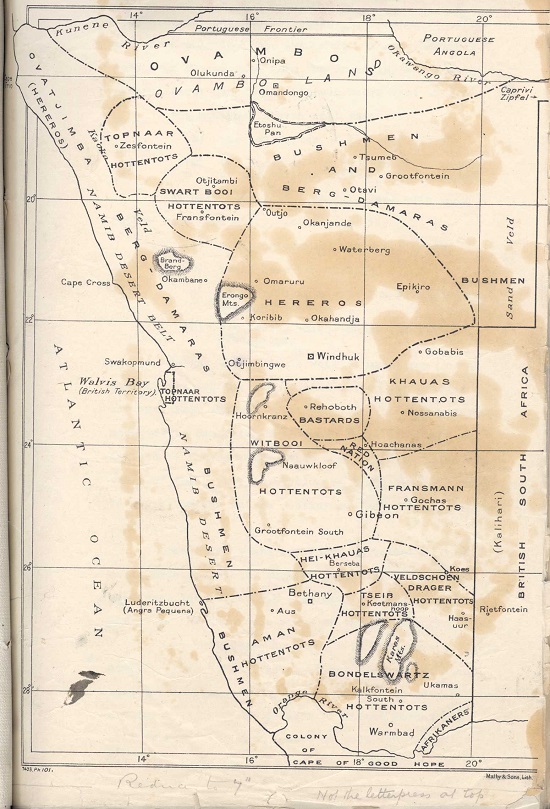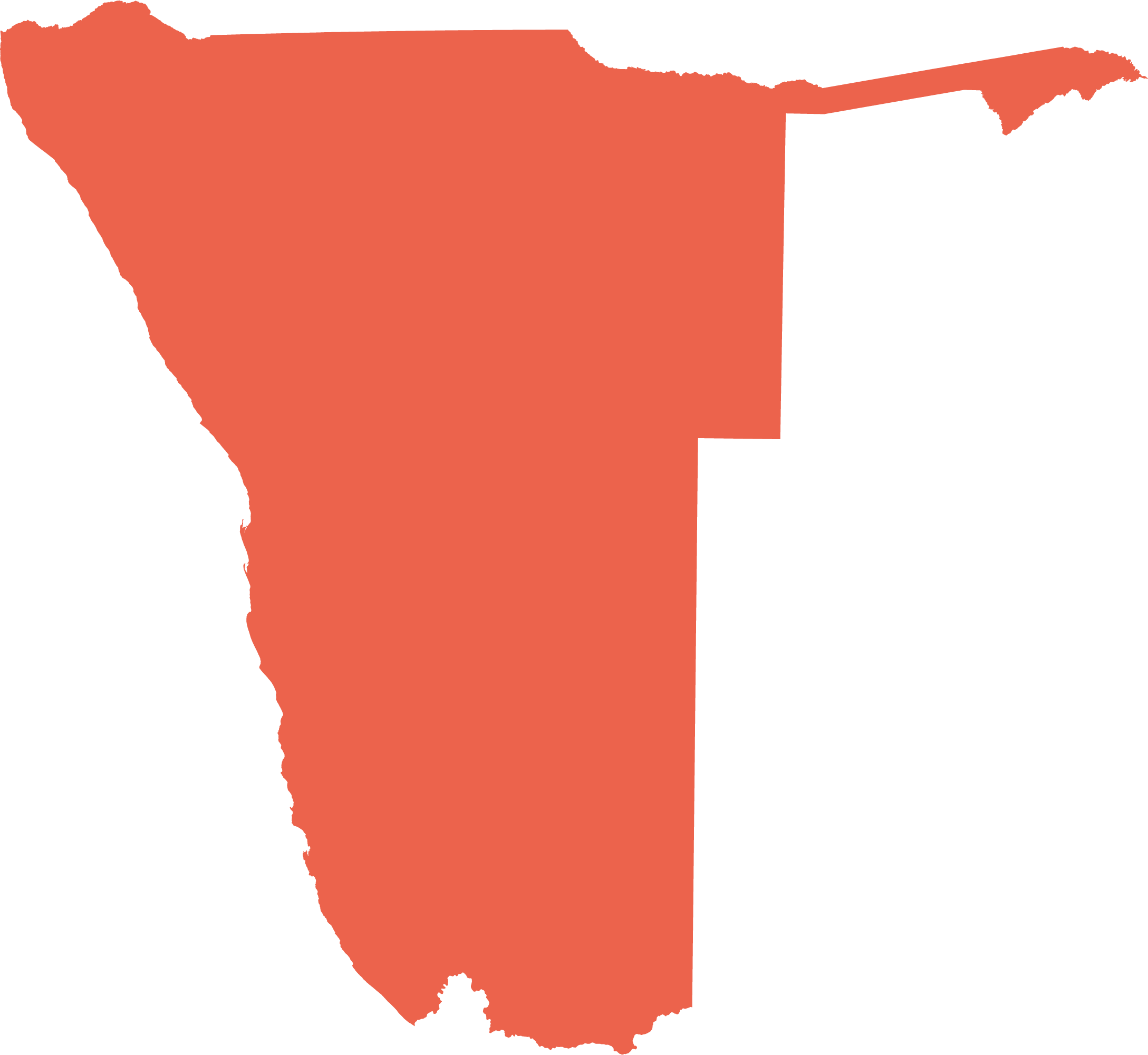People on the move
Migrations from centuries past14
Certainty about what happened in the past becomes more difficult the further back we go. In the absence of written accounts, much about Namibia's history over the past few thousand years had to be assumed from oral histories or interpreted from archaeological remains. More recently, studies of genetic and linguistic relationships have shed new light on the origins and affinities of Namibians.15
Three aspects of early Namibian history seem rather clear. First, the relatively few people who lived here until about 2,000 years ago made a living by hunting, foraging and gathering. Second, those earliest Namibians were then joined at different times by groups of Khoekhoegowab speaking pastoralists and Bantu agro-pastoralists; these were Namibia's first livestock and crop farmers. Third, many more immigrants, in turn, arrived in Namibia over the past several hundred years. Most have come from Angola, whilst others came from South Africa, Europe and elsewhere in Africa. It is probably true that most Namibians are descendants of people who immigrated here less than four or five generations back – within the last 150 years.16 All of this reflects the mobility and adaptability of Namibians, which continues today as more and more people move from rural areas and livelihoods to towns and cities and the urban livelihoods offered there.

Photo: Adapted from Google Earth
Few of the world's international borders are as visible from space as the one between northern Namibia and southern Angola. Most conspicuous is the boundary across the Cuvelai drainage system north of Etosha. The straight line separates the darker, more wooded area in Angola where there are fewer people, from the paler, more denuded and populated part in Namibia. Of all the people living in the Cuvelai, approximately 35 per cent live in Angola and 65 per cent in Namibia.17
A similar effect of high densities of people is also visible along the Okavango River where very few people live on the northern, Angolan riverbank, whereas tens of thousands of people live along the river on the southern, Namibian side. The road from Rundu to Mururani is also clear in the image because most trees have been cleared either side of the road by the many people living there.
9.08 Distribution and migrations of people over the past 1,200 years

Although many of the details of directions, dates and names on this map are approximations, they present a reasonable perspective on where many people lived and came from over the past 12 centuries.18 Importantly, blank areas on the map reflect a lack of information rather suggesting that people were absent from those areas. San people, comprising distinct but related hunter-gatherer groups, and their ancestors were probably the only residents for tens of thousands of years, as suggested by archaeological evidence. Those early residents were apparently widespread, probably regularly moving over large areas between sources of water, productive hunting grounds and plants brought to life by sporadic, often patchy rains. Namibia's climate was at times much wetter or much drier than it is now, and people would have migrated from one area to another accordingly.
Bantu farmers and pastoralists and Khoekhoe pastoralists probably began to enter Namibia about 1,200 years ago, perhaps even earlier. Oral accounts place many of the immigrations in the 1500s or thereabouts, but these later dates may be on record because word-of-mouth accounts are only recalled with some credibility over short periods of history.
Herero (including Himba), Damara, Aawambo and Kavango people were likely derived from agro-pastoralists living in the central highlands of Angola, who themselves descended from earlier Bantu migrants that moved south from Cameroon.19 People who settled in Zambezi probably moved from Bantu origins north and east of here. Khoekhoe pastoralists are thought to have come from East Africa to South Africa, and then into Namibia.
More recent immigrations are better documented. Between 1730 and 1870 large numbers of Oorlam people from South Africa's Cape moved into central and southern Namibia. Rehoboth Basters also moved from the Cape to settle at Rehoboth in 1870. In 1908, the German Schutztruppe's defeat of Herero and Nama forces encouraged a significant influx of German settlers who acquired land, as did demobilised German soldiers. Some white farmers from northwestern South Africa moved into Namibia before 1915, but many more came to acquire farms after World War I when South Africa was granted mandate over Namibia.
Also in 1915, some 25,000 Ovakwanyama people moved from Angola into northern Namibia following the Portuguese victory over their king, Mandume ya Ndemufayo. This immigration increased the number of Aawambo people in Namibia by about 30 per cent. More immigration followed as Angolans fled rural taxation and forced labour, and later the hostilities during the Angolan Civil War (1975–2002). Many people were – and continue to be – attracted by economic opportunities and health and education services in Namibia, all of which has led to the rapid growth of populations in Kavango East, Kavango West, Ohangwena, Omusati, Oshana and Oshikoto regions.
9.09 Namibia in the late 1800s20

This map provides perspectives on how and where various groups of people were distributed in the country before substantial colonial settlement. The Caprivi, as it was then known (now Zambezi Region), was added to the German colony in 1890.
At that time most European explorers, missionaries and colonial authorities tended to focus their attention on southern and central Namibia, where their maps depict much more detail than they do about the north; this reflects the substantial interests that colonists had in land in southern and central Namibia. Central Namibia had been long known as Damaraland (and later, Hereroland), while southern Namibia was known as Great Namaqualand.
No mention is made of different groups or separate communities in Kavango – the map simply indicates most of the northern area as being occupied by the 'Ovambos'.
9.10 Northern Namibia in the late 1800s and early 1900s21


Northern Namibia lay beyond the 'Police Zone' – the area that the German administration proclaimed for white settlement in 1907 (figure 8.27). These northern areas were thus left largely to their own devices under their own rulers, usually with little regard for the identities of the societies living there. However, many societies with defined names, languages, memberships and leaderships had long been in existence, probably at least since the 1600s. Much of that diversity remains today in the many languages and dialects spoken in northern Namibia (figure 9.14).
That diversity and the strong, often monarchical traditional leadership systems in northern Namibia developed in association with agro-pastoralism. By contrast, pastoral societies have generally been more mobile with less-distinctive borders, membership and governance systems.

